
Emotional Reasoning is a cognitive process by which we believe that what we are feeling is true even in the absence of evidence that supports our feelings. In some cases, there may actually be evidence that disproves our feelings!
To recap what we have learned so far in this series, cognitive distortions are beliefs and thoughts that present themselves automatically and coerce us to believe they are true. They are invasive, stubborn, and often outside the realm of conscious awareness. Our task, then, is to become aware of them so that they may be challenged and defeated when necessary. Emotional reasoning is a particularly hard distorted thought process to overcome because we are taught to “trust our gut.” If we trust our gut in this instance, we will act on thoughts and beliefs that could become very limiting and cause full blown panic disorder.
The most drastic case of emotional reasoning that I can think of is an incident from my own life that had very serious consequences. Like many other people, I am terrified of heights. My husband and I were visiting Sedona, Arizona with some friends. We thought it would be fun to rent ATVs and explore the area. Call me stupid, but I didn’t realize we would be traveling along mountainous terrain where there were no guard rails for safety.
I was terrified.
In fact, I was so terrified that I convinced myself that the only way to stay safe was to hug the inside of the mountain – as far away from the edge as I could get. As it turns out, that wasn’t such a smart move because my two right wheels became unbalanced as they went slightly up the side of the mountain and it caused the ATV to tip over with me under it. I ended up with a ruptured spleen, internal bleeding, and a collapsed lung (not to mention surgery and a long stay in the hospital). When I look back on that incident, I can clearly see that my emotional reasoning caused the accident. I was so convinced – based on my fear – that I was in danger that I over-compensated and caused myself harm.
Fortunately, most cases of Emotional Reasoning aren’t so drastic that they cause bodily harm. Unfortunately, they can and do cause psychological harm all the time. For instance, say I’m attending a meeting with my peers. They are smart people and bring up some items for discussion that I don’t have a clue about. My thought might be, “Oh, wow! I didn’t even know that. I’m really stupid!” Strong waves of inadequacy might flow over me and, since I don’t want to show my “stupidity,” I would keep quiet and not contribute to the conversation. After the meeting, the feelings of inadequacy stay with me and I become depressed and despondent. My self-confidence is at an all- time low, which shows up in the way I interact with my clients. From there…well, you get the picture. It is a downward spiral that can lead to negative consequences in all areas of my life.
While this is a fictional account of what might happen, it’s not far off of what has happened to me in the past. When emotional reasoning prevails, I am taking my emotions to be the absolute truth. If I feel guilty, I must have done something wrong. If I feel overwhelmed and inadequate, I must be a worthless loser. If I feel frightened, the situation I am in must be dangerous. The list could go on forever.
It is fortunate that we don’t have to stay in this spot. We can climb out, question our thinking, and come up with thoughts that are much more realistic.
Let’s look at my example of what happened on the mountain in Sedona. What if I had stopped for a moment and asked myself some questions? Might I have been able to bring some reason into the situation which could have prevented the whole unfortunate incident? While I can’t say this for sure, I think it might have. Let’s see what the process might have looked like.
- We start up the mountain and the fear threatens to take over. I think, “Oh no! There aren’t any guardrails. I’m never going to be able to go up this mountain.” At this point I have started the downward spiral.
- Is it true that I couldn’t go up the mountain because there were no guardrails? Plenty of other people were traveling up the same mountain safely. So, the point above is not true.
- Is there something else that is more true? No guard rail does not mean that I am going to fall off the mountain. “If I stay in the middle, away from the edge, I should be fine.” That thought sounds more reasonable.
- What is the evidence that I can’t make it up the mountain because there is no guardrail? I can’t think of any evidence.
- What is the evidence that I could make it up the mountain even though there is no guardrail? There are a lot of people in front of me and some already coming down who made it safely. As far as I know nobody has fallen off the side. This sounds like pretty good evidence to me.
- Conclusion: There is nothing stopping me from going up the mountain except my own fears which are caused by my own thoughts.
- Strategy: Stop. Take some deep breaths. Go through the above questions. Calm myself enough to continue or tell myself that I would rather not proceed even though the evidence is strong for the fact that I am not likely to fall off the mountain.
Even if I had chosen not to proceed I would have won over my thoughts. The important thing is that I recognize them as being distorted and unproductive. (Overcoming my phobia surrounding heights is for another post.)
The point I would like to make here is not that you should push yourself to do things you are afraid of. Rather, it is that you need to understand that your own thoughts are causing the fear. There are no facts to back up the fear. It is irrational. My guess is that I would have continued up the mountain safely, albeit somewhat fearfully. I would have made it down safely and I would have felt pretty good about overcoming the fear in the end. However, it would have been every bit as much of a victory if I had chosen to stay behind. I would have made the decision intentionally with full knowledge of the facts. Phobias are complicated and need more work than offered here, but this is where that work starts.
What about the “trusting your gut” thing? Someday soon, I’ll write another post about that, but for now I would just like to leave you with the thought that trusting your intuition is different than trusting your fear. While neither has a lot of supporting evidence, when we trust our intuition we usually do so with a sense of peace. There is very little fear. Even if our intuition says there is danger, we are making our decisions quite intentionally with thought clarity that surpasses that which is reasonable. When we are engaging in emotional reasoning there is no peace or clarity of thought.
Here are the steps:
- Identify what your emotional reasoning thought is. Be as accurate as you can.
- Ask yourself, “Is this true?” and, “What are the facts?”
- Ask, “Is there anything that could be more true?”
- What is the evidence for or against your thoughts?
- Come to a conclusion.
- What are your choices?
- Identify your strategy.
Distorted thinking is common. Not a single person is immune to it. We have a choice, though. We can let it disable us or we can take control of it. You better bet that if I’m ever put in a situation like the example above again, I will handle it differently. If you would like to handle your distorted thinking differently and you would like a coach to walk the road with you, please give me a call. I would be honored to be the one you choose to take along with you.


